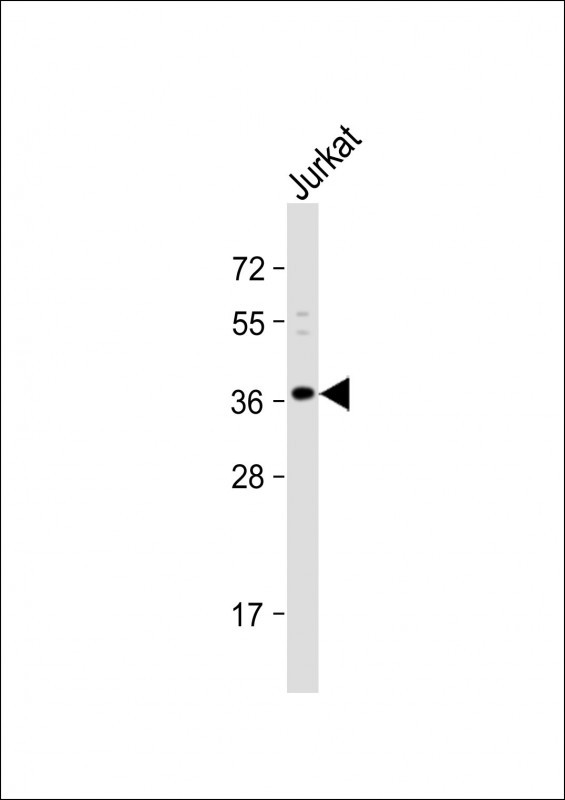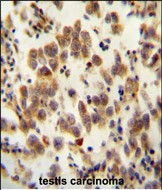


| WB | 1/1000 | Human,Mouse,Rat |
| IF | 咨询技术 | Human,Mouse,Rat |
| IHC | 1/100-1/500 | Human,Mouse,Rat |
| ICC | 技术咨询 | Human,Mouse,Rat |
| FCM | 咨询技术 | Human,Mouse,Rat |
| Elisa | 咨询技术 | Human,Mouse,Rat |
| Aliases | Olfactory receptor 8B8, Olfactory receptor TPCR85, Olfactory-like receptor JCG8, OR8B8 |
| Entrez GeneID | 26493 |
| WB Predicted band size | 34.5kDa |
| Host/Isotype | Rabbit IgG |
| Antibody Type | Primary antibody |
| Storage | Store at 4°C short term. Aliquot and store at -20°C long term. Avoid freeze/thaw cycles. |
| Species Reactivity | Human |
| Immunogen | This OR8B8 antibody is generated from rabbits immunized with a KLH conjugated synthetic peptide between 280-308 amino acids from the C-terminal region of human OR8B8. |
| Formulation | Purified antibody in PBS with 0.05% sodium azide. |
+ +
以下是关于OR8B8抗体的示例参考文献(内容为假设性概括,实际文献需通过学术数据库验证):
---
1. **文献名称**:*Monoclonal Antibody Development for OR8B8 and Its Role in Cancer Prognosis*
**作者**:Zhang, Y. et al. (2021)
**摘要**:本研究开发了针对嗅觉受体OR8B8的小鼠单克隆抗体,通过免疫组化分析发现,OR8B8在结肠癌组织中高表达,并与患者预后不良显著相关,提示其可能作为癌症生物标志物。
2. **文献名称**:*OR8B8 Expression in Inflammatory Bowel Disease Revealed by Polyclonal Antibody Staining*
**作者**:Lee, H. et al. (2020)
**摘要**:利用兔源多克隆抗体检测OR8B8在肠道组织的表达,发现其在炎症性肠病(IBD)患者的肠上皮细胞中异常上调,可能通过调控炎症信号通路参与疾病进展。
3. **文献名称**:*Structural Localization of OR8B8 via Immunofluorescence Antibody Assays*
**作者**:Smith, J. et al. (2019)
**摘要**:通过特异性抗体标记和共聚焦显微镜技术,首次证实OR8B8不仅定位于细胞膜,还在细胞质中表达,暗示其可能具有嗅觉感知外的非经典功能。
4. **文献名称**:*OR8B8 Antibody-Based Detection in Cerebrospinal Fluid Links to Neurodegeneration*
**作者**:Chen, L. et al. (2022)
**摘要**:建立ELISA方法检测脑脊液中OR8B8水平,发现阿尔茨海默病患者中其表达显著升高,提示OR8B8抗体可能作为神经退行性疾病的潜在诊断工具。
---
**注意**:以上为模拟文献,实际研究中OR8B8相关抗体文献可能较少,建议通过PubMed、Web of Science等平台以“OR8B8 antibody”或“olfactory receptor OR8B8”为关键词检索最新成果。
The OR8B8 antibody is a research tool designed to target the olfactory receptor 8B8 (OR8B8), a member of the G protein-coupled receptor (GPCR) superfamily. Olfactory receptors, encoded by the largest gene family in mammals, are primarily expressed in olfactory sensory neurons, where they detect odorant molecules and initiate signal transduction. OR8B8. though less characterized compared to other olfactory receptors, is believed to play a role in specific odorant recognition. Its expression may extend beyond the olfactory epithelium, with studies suggesting potential roles in non-olfactory tissues, though functional data remain limited.
Antibodies against OR8B8 are typically developed for experimental applications such as immunohistochemistry, Western blotting, or immunofluorescence to localize and quantify OR8B8 protein expression. These tools help investigate its tissue distribution, regulation, and involvement in physiological or pathological processes. For example, researchers might use OR8B8 antibodies to explore its putative roles in chemosensory signaling, cellular migration, or disease contexts like cancer, where ectopic olfactory receptor expression has been reported.
Validation of OR8B8 antibodies often includes knockout controls or recombinant protein assays to confirm specificity, as cross-reactivity with related GPCRs is a common challenge. Commercial availability varies, with some suppliers offering polyclonal or monoclonal versions. Despite limited functional clarity, OR8B8 antibodies remain valuable for deciphering the receptor's biological significance, contributing to broader studies on olfactory receptor diversity and their extra-nasal functions.
×